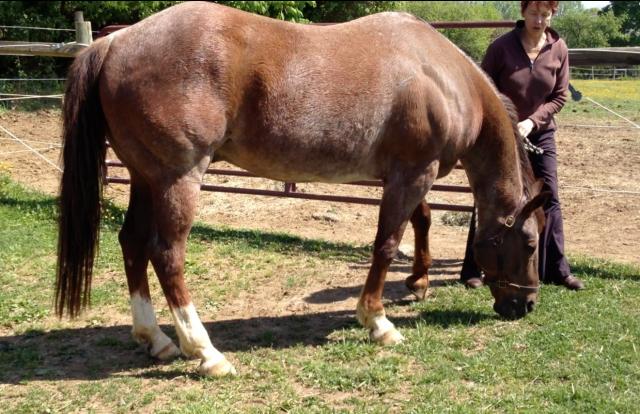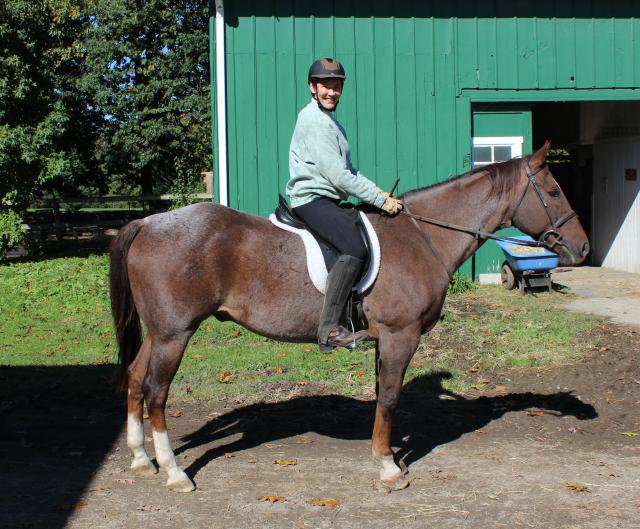As hoof care providers we often get calls to help horses as a last-ditch effort before euthanasia. The owner calls with a laundry list of problems and a history of solutions that have been tried and fallen short.
This is the case of a 19-year-old Quarter Horse gelding whose laundry list was a mile long. He had been diagnosed with:
- bowed right front tendon
- left front coffin bone fracture
- sidebone
- ringbone
His current diagnosis was navicular disease. When I first saw him he was barely walking on his left front leg. Many options had been tried to resolve his lameness but with minimal long term success. The owner was tired of watching him in pain and was considering euthanasia. The veterinarian who referred me to the case told the owner “Call Daisy, she may be able to perform a miracle for you”…no pressure!

Anytime I come across a horse with arthritic conditions, navicular, etc my goals as a farrier are to minimize the range of motion the joints have to articulate through, hopefully minimizing the impact any soft tissue problems or rough bone surfaces may have as the horse moves. The more compact the foot, the shorter the distance the joints have to move in locomotion.
I have discussed my basic trimming and shoeing goals in previous blogs. The same goals apply in this situation as the other case studies I have highlighted.
My goals are:
- 3-8 degree palmar P3 angle: the angle of the bottom of the coffin bone in relation to the ground.
- 50/50 base of support from toe to heel around the center of rotation of the hoof capsule.
Here is the horse’s left front foot when I came to see him:


Goal:
P3 Palmar Angle: 3-8 degrees
Toe Support % (50/50) 50% toe
May 8th Old Shoe:
P3 Palmar Angle: NEGATIVE -1.70 degrees
Toe Support % (50/50) 59.17% toe
I really respect what the previous farrier was doing with this horse. The shoe is well fit, and the rolled toe was working to help this horse with his lameness issue. However the internal and external hoof alignment was not quite to my parameters, so I felt increasing the palmar P3 angle and getting closer to a true 50/50 support base would have a good chance at helping this horse become more comfortable if not sound.
Here is the same foot, same day, with the shoe pulled:

May 8th No Shoe:
P3 Palmar Angle: NEGATIVE -3.69 degrees
Toe Support % (50/50) 63.51% toe
So without the shoe the hoof capsule and internal alignment was worse.
Here is what we were able to do in our first trim the same day:

Goal:
P3 Palmar Angle: 3-8 degrees
Toe Support % (50/50) 50% toe
May 8th After Trim:
P3 Palmar Angle: POSITIVE 2.90 degrees
Toe Support % (50/50) 56.70% toe
So we were getting much closer to our ideal parameters. I felt I had pushed this foot as much as possible at this time. We left him barefoot in a dry lot paddock. The horse became much more comfortable and at a walk was sound. But at a trot, especially on firm ground or on turns he was still off.
I felt I had achieved as much improvement as I could achieve in his internal and external hoof alignment through trimming. I wondered if he even could become sound at the trot and on turns, especially on hard ground. We decided to use leverage testing to determine where his discomfort was coming from. An easy way to do leverage testing is with the KrossCheck leverage testing system.
The leverage testing revealed that the horse hated his toe elevated (functionally decreasing his palmar P3 angle) and was very happy with additional heel elevation (increasing the palmar P3 angle) which made a lot of sense. However, it was interesting to find that he also hated his foot being tipped from side to side, medial/lateral. I decided to try a glue on shoe to create ease of range of motion from side to side as well as add a bit more heel height.
Here is what his foot looked like with the addition of the composite shoe:

June 14th New Composite Shoe:
P3 Palmar Angle: POSITIVE 5.74 degrees
Toe Support % (50/50) 50.20% toe
With the additional mechanics created in the shoe, and the shock dampening effect of the plastic, this horse went completely sound and is now back in work being ridden for trail riding, light dressage lessons, and some therapeutic riding five days a week. The leverage testing was an invaluable tool in getting this horse, with his laundry list of problems, back in work and sound. Here is his very happy owner enjoying her horse!

Daisy Bicking, APF




